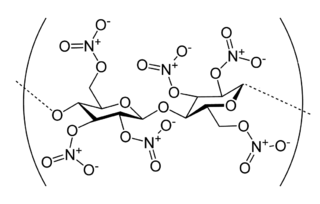
Barium is a chemical element; it has symbol Ba and atomic number 56. It is the fifth element in group 2 and is a soft, silvery alkaline earth metal. Because of its high chemical reactivity, barium is never found in nature as a free element.

Dynamite is an explosive made of nitroglycerin, sorbents, and stabilizers. It was invented by the Swedish chemist and engineer Alfred Nobel in Geesthacht, Northern Germany, and was patented in 1867. It rapidly gained wide-scale use as a more robust alternative to the traditional black powder explosives. It allows the use of nitroglycerine's favorable explosive properties while greatly reducing its risk of accidental detonation.

An explosive is a reactive substance that contains a great amount of potential energy that can produce an explosion if released suddenly, usually accompanied by the production of light, heat, sound, and pressure. An explosive charge is a measured quantity of explosive material, which may either be composed solely of one ingredient or be a mixture containing at least two substances.

Gunpowder, also commonly known as black powder to distinguish it from modern smokeless powder, is the earliest known chemical explosive. It consists of a mixture of sulfur, charcoal, and potassium nitrate (saltpeter). The sulfur and charcoal act as fuels while the saltpeter is an oxidizer. Gunpowder has been widely used as a propellant in firearms, artillery, rocketry, and pyrotechnics, including use as a blasting agent for explosives in quarrying, mining, building pipelines, tunnels, and roads.

Imperial Chemical Industries (ICI) was a British chemical company. It was, for much of its history, the largest manufacturer in Britain. It was formed by the merger of four leading British chemical companies in 1926. Its headquarters were at Millbank in London. ICI was a constituent of the FT 30 and later the FTSE 100 indices.

Nitroglycerin (NG), also known as trinitroglycerin (TNG), nitro, glyceryl trinitrate (GTN), or 1,2,3-trinitroxypropane, is a dense, colorless, oily, explosive liquid most commonly produced by nitrating glycerol with white fuming nitric acid under conditions appropriate to the formation of the nitric acid ester. Chemically, the substance is an organic nitrate compound rather than a nitro compound, but the traditional name is retained. Discovered in 1847 by Ascanio Sobrero, nitroglycerin has been used as an active ingredient in the manufacture of explosives, namely dynamite, and as such it is employed in the construction, demolition, and mining industries. It is combined with nitrocellulose to form double-based smokeless powder, which has been used as a propellant in artillery and firearms since the 1880s.

Trinitrotoluene, more commonly known as TNT, more specifically 2,4,6-trinitrotoluene, and by its preferred IUPAC name 2-methyl-1,3,5-trinitrobenzene, is a chemical compound with the formula C6H2(NO2)3CH3. TNT is occasionally used as a reagent in chemical synthesis, but it is best known as an explosive material with convenient handling properties. The explosive yield of TNT is considered to be the standard comparative convention of bombs and asteroid impacts. In chemistry, TNT is used to generate charge transfer salts.

Cordite is a family of smokeless propellants developed and produced in Britain since 1889 to replace black powder as a military firearm propellant. Like modern gunpowder, cordite is classified as a low explosive because of its slow burning rates and consequently low brisance. These produce a subsonic deflagration wave rather than the supersonic detonation wave produced by brisants, or high explosives. The hot gases produced by burning gunpowder or cordite generate sufficient pressure to propel a bullet or shell to its target, but not so quickly as to routinely destroy the barrel of the gun.

Nitrocellulose is a highly flammable compound formed by nitrating cellulose through exposure to a mixture of nitric acid and sulfuric acid. One of its first major uses was as guncotton, a replacement for gunpowder as propellant in firearms. It was also used to replace gunpowder as a low-order explosive in mining and other applications. In the form of collodion it was also a critical component in an early photographic emulsion, the use of which revolutionized photography in the 1860s. In the 20th century it was adapted to automobile lacquer and adhesives.

Ammonium nitrate is a chemical compound with the formula NH4NO3. It is a white crystalline salt consisting of ions of ammonium and nitrate. It is highly soluble in water and hygroscopic as a solid, although it does not form hydrates. It is predominantly used in agriculture as a high-nitrogen fertilizer.
Octanitrocubane (molecular formula: C8(NO2)8) is a proposed high explosive that, like TNT, is shock-insensitive (not readily detonated by shock). The octanitrocubane molecule has the same chemical structure as cubane (C8H8) except that each of the eight hydrogen atoms is replaced by a nitro group (NO2). As of 1998, octanitrocubane had not been produced in quantities large enough to test its performance as an explosive.

Smokeless powder is a type of propellant used in firearms and artillery that produces less smoke and less fouling when fired compared to black powder. Because of their similar use, both the original black powder formulation and the smokeless propellant which replaced it are commonly described as gunpowder. The combustion products of smokeless powder are mainly gaseous, compared to around 55% solid products for black powder. In addition, smokeless powder does not leave the thick, heavy fouling of hygroscopic material associated with black powder that causes rusting of the barrel.

Barium nitrate is the inorganic compound with the chemical formula Ba(NO3)2. It, like most barium salts, is colorless, toxic, and water-soluble. It burns with a green flame and is an oxidizer; the compound is commonly used in pyrotechnics.

Gunshot residue (GSR), also known as cartridge discharge residue (CDR), gunfire residue (GFR), or firearm discharge residue (FDR), consists of all of the particles that are expelled from the muzzle of a gun following the discharge of a bullet. It is principally composed of burnt and unburnt particles from the explosive primer, the propellant (gunpowder), stabilisers and other additives. The act of firing a bullet incites a highly pressurised, explosive reaction that is contained within the barrel of the firearm, which expels the bullet. This can cause the bullet, the barrel, or the cartridge to become damaged, meaning gunshot residue may also included metallic particles from the cartridge casing, the bullet jacket, as well as any other dirt or residue contained within the barrel that could have become dislodged.

2-Nitrodiphenylamine is an organic chemical with the formula C6H5NHC6H4NO2. It is a nitrated derivative of diphenylamine. It is a red solid, usually found in form of flakes or powder. It is polar but hydrophobic.
A pyrotechnic composition is a substance or mixture of substances designed to produce an effect by heat, light, sound, gas/smoke or a combination of these, as a result of non-detonative self-sustaining exothermic chemical reactions. Pyrotechnic substances do not rely on oxygen from external sources to sustain the reaction.
Nobel Enterprises is a chemicals business that used to be based at Ardeer, in the Ayrshire town of Stevenston, in Scotland. Specialising in nitrogen-based propellants and explosives and nitrocellulose-based products such as varnishes and inks. It was formerly ICI Nobel, a division of the chemicals group ICI, but was then sold to Inabata, a Japanese trading firm. The business was sold on to Chemring Group in 2005 and is now a Scottish Company, part of Chemring Group. Stefan Donald is currently the lead engineer for the ongoing regeneration project.
Polyvinyl nitrate (abbreviated: PVN) is a high-energy polymer with the idealized formula of [CH2CH(ONO2)]. Polyvinyl nitrate is a long carbon chain (polymer) with nitrate groups bonded randomly along the chain. PVN is a white, fibrous solid, and is soluble in polar organic solvents such as acetone. PVN can be prepared by nitrating polyvinyl alcohol with an excess of nitric acid. Because PVN is also a nitrate ester such as nitroglycerin (a common explosive), it exhibits energetic properties and is commonly used in explosives and propellants.

Firearm propellants are a specialized type of propellant used to discharge a projectile through the barrel of a firearm. Mixtures of different chemical substances are often used to control the rate of gas release, or prevent decomposition of the propellant prior to use. Short-barrel firearms such as handguns necessitate faster-burning propellants to obtain sufficient muzzle energy, while long guns typically use slower-burning propellants. The pressure relationships between propellant chemical reactions and bullet response are described as internal ballistics.

Virginia Dolores Hogan was an American chemist, specializing in pyrotechnics, and "the only woman research chemist at Picatinny Arsenal," a large United States Army installation in New Jersey.
















